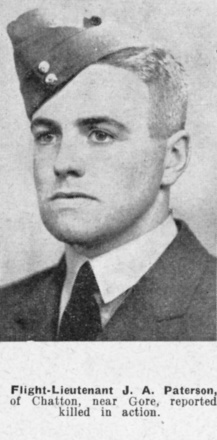DOMINION CASUALTIES
YOUNG PILOT KILLED
FLYING-OFFICER J. A. PATERSON
Advice that Flying-Officer James Alfred Paterson of Chatton, near Gore, had been killed in action, was received by relatives in Auckland yesterday. Flying-Ofhcer Paterson was the elder son of Mr. S. B. Paterson, of Chatton, and was nearly 21 years old. He was educated at the Gore High School and, after training at Taieri and Wigram, left for England early last year with a short service commission in the Royal Air Force. On completion of his training he was posted to a squadron. He took part in the operations in Flanders and the evacuation at Dunkirk. The advices concerning his death indicated that he lost his life in a fierce air battle. -NZ Herald, 1/10/1940.

James Alfred Paterson was born at Chatton in the district of Gore, Southland, New Zealand on 16th October 1919 and worked on his father's farm.
He was a trooper in the Otago Mounted Rifles, Territorial Army. In December 1937 he applied for an RNZAF short service commission and after acceptance he began flying training at the Otago Aero Club, gaining his 'A' License on 15th August 1938. Paterson was posted to No 1 FTS, Wigram on 6th September and was awarded his flying badge on 17th December. He completed his training and sailed for the UK on the 'Waimarama' from Auckland on 17th April 1939.
Paterson was posted to 82 Squadron at Cranfield on 3rd June. At the outbreak of war he went to 71 Wing in France, flying Magisters on reconnaissance patrols and observation flights for the BEF. In late 1939 Paterson joined 226 Squadron at Rheims. In May 1940 he was detached to special duties to supply hard-pressed squadrons with mail, medical supplies, petrol and despatches. After the French collapse in June Paterson went with 226 Squadron to Northern Ireland. He volunteered for Fighter Command and after converting to Spitfires at 7 OTU Hawarden he joined 92 Squadron at Pembrey.
On 24th July Paterson shared in the destruction of a Ju88. He shared another on 19th August and destroyed a Me110 on 11th September. Later the same day he was shot down by Me109’s and baled out, with his clothes on fire and badly burned about the face. His Spitfire, R6613, crashed north-east of Ashford. Paterson insisted on flying again before he could see properly. On 27th September he took off with other Spitfires of 92 to intercept enemy aircraft. He was shot down in flames by Me109’s near Maidstone. Fellow pilots saw him struggling to escape from his cockpit but he failed to do so and was killed. His Spitfire, X4422, crashed and burned out at Sparepenny Lane, Farningham.
Paterson is buried in Star Lane Cemetery, Orpington, Kent.
He was made an MBE (gazetted 1st January 1941) for his outstanding services in France in May 1940. -The Battle of Britain London Monument.
The Miles Magister, which James flew on operations over France in 1940, was a monoplane advanced trainer, used in squadron service for liaison duties. It was not designed for anything else. Its top speed was 142mph (229kmh) and James flew them in a sky where the enemy had effectively gained superiority with its Messerschmitt Bf-109 fighter. The 109 was more than twice as fast as the Magister.
BELATED CONFIRMATION
AWARD TO N.Z. AIRMAN
Advice has now been received by Mr S. B. Paterson, of East Chatton, near Gore, that a posthumous award of the membership of the Most Excellent Order of the British Empire (M.B.E.) to his son, Acting Flight-lieutenant James Alfred Paterson, who was killed in action in September, was included in the New Year service honours to members of the Royal Air Force born in New Zealand. At the time of the publication of the honours Acting Flight-lieutenant Paterson was referred to as Pilot-officer J. A. Paterson, of Dunedin. Mr Paterson was fairly certain that the award had been bestowed on his son, but because of lack of official advice he could not make this claim. The secretary of the Dunedin Returned Soldiers’ Association (Mr 0. L. Ferens) instituted inquiries, and advice has now been received that the award was made to Air Paterson’s son. who was erroneously designated a pilot officer.
The young airman, who was only 21, began his flying career at Taieri aerodrome in July, 1938, going to Wigram later that year for advanced training. He completed his course in March, 1939, and sailed for England the following month with the rank of acting pilot officer, and joined the R.A.F.
On the outbreak of war he went to France with one of the first bombing squadrons sent there, and he took a very active part in the fierce fighting of last May. His subsequent career was not devoid of excitement, and in July, 1940, he brought down his first enemy plane, a Junkers 88, encountered at a height of 18,000 ft. In all he accounted for 15 machines.
On September 15 last when flying at a height of 28,000 ft, the wing of his machine was shot away. He baled out by parachute, losing consciousness on the way down. He recovered, and was able to open his parachute at a height of only 6,000 ft. He was fairly severely bruised by the force of his landing, but was soon able to resume his duties. Another escape occurred once when his machine was shot down over the Channel. He again baled out and was rescued in the water. His parents have received from him a German “Mae West” (a special vest worn when flying at high altitudes), a flying officer’s kit, a flying helmet, and other souvenirs.
Prior to joining the Air Force, Acting-flight-lieutenant Paterson was for three years with the Otago Mounted Rifles. -Evening Star, 22/1/1941.
 |
| Orpington Cemetery, Kent, UK. |
 |
| Waikaka Cemetery, NZ. |
No comments:
Post a Comment